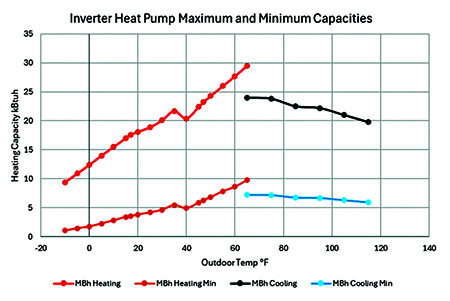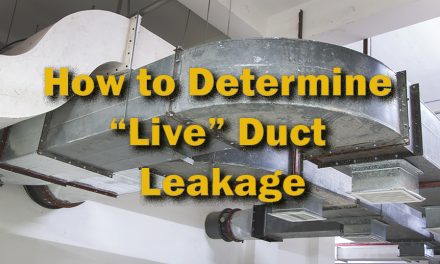As inverter-based heat pumps become more common, I’m surprised to hear from some contractors and homeowners that humidity control has become more of an issue than it was with single or two-stage equipment. We all know humidity is removed in cooling mode, but only when the system runs.

Inverter systems are designed to operate at a lower capacity for longer periods, theoretically improving their dehumidification performance. So, what is happening, and how can we ensure we don’t end up with unhappy customers due to high humidity after they shell out big money for a shiny new system?
Equipment Sizing
Equipment sizing was the first thing that came to mind as I started thinking about this issue. I sometimes hear a repeated myth that sizing doesn’t matter with inverter systems – you can oversize them, and they will operate at a lower capacity.

equipment heating and cooling capacities.
The system will cycle on and off below the orange and
blue lines to meet the load.
While it’s true that inverter systems can modulate down to meet a lower load, there is a limit to how low they can go. If a system is oversized, it will need to shut down more often in low sensible load, high humidity scenarios (i.e., shoulder seasons, summer nights, etc.). The closer the maximum capacity at design conditions matches the peak cooling load, the better the system will dehumidify.
Oversizing has been a rampant problem in our industry for decades, and so has the paradigm of like-for-like equipment replacement or even going up a size if the occupants aren’t comfortable with their current system.
Gas-fired furnaces tend to be even more oversized than traditional heat pumps, so replacing a furnace with a heat pump of the same capacity is likely drastically oversized. Completing heating and cooling load calculations for new heat pumps is critical.
In humid areas, you should take another step with load calculations. Currently, load calculation software automatically breaks down sensible and latent loads for the location you select, but only for peak cooling conditions. Peak latent loads don’t usually occur under peak cooling conditions, so checking the loads under peak dehumidification conditions is necessary.
Unfortunately, most programs don’t provide these conditions automatically based on location, so you must manually enter them.
Load Calculations Software Inputs
To find the peak dehumidification conditions, you can visit ASHRAE Meteo and find the location. The conditions provided are in terms of Dew Point (DP), Humidity Ratio (HR), and Mean Coincident Dry Bulb (MCDB).
Click Below for the Next Page:













Recent Comments